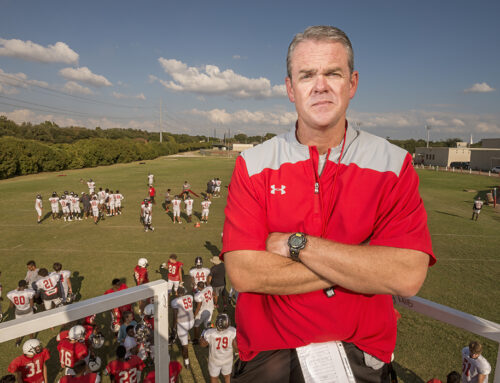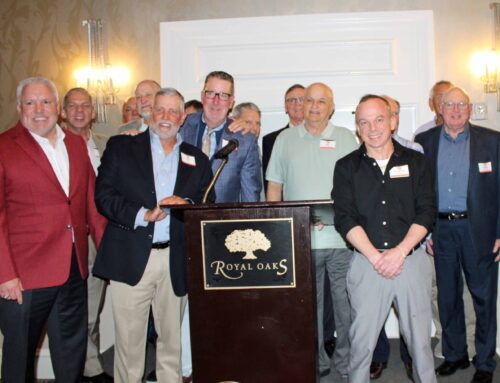Before we become a bike-savvy city, we have a lot to learn
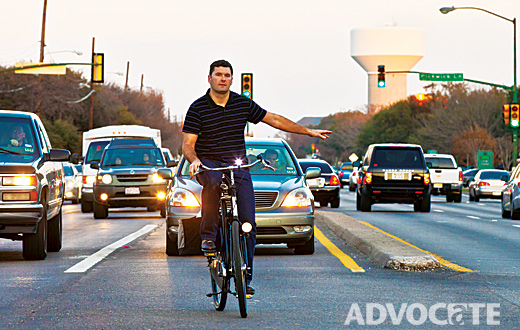
Waco Moore rides his bike in traffic during rush hour on Northwest Highway. To most cyclists, this type of commute is unpleasant and even terrifying. To Moore, and a few like him, it’s mundane. Photo by Danny Fulgencio
• Catch up on our coverage of the Dallas Bike Plan.
• Scroll down this article for cycling video, cycling rules and information on bike lessons.
Dallas, with its car-clogged streets and hurried drivers, can be a dangerous place for bicycle commuters. But watching 60-year-old Bill Bryan, in loafers and a navy sports coat, pedal his 1972 Raleigh up a quiet street, there is no indication, save the helmet on his head, that he comprehends the potential perils awaiting him.
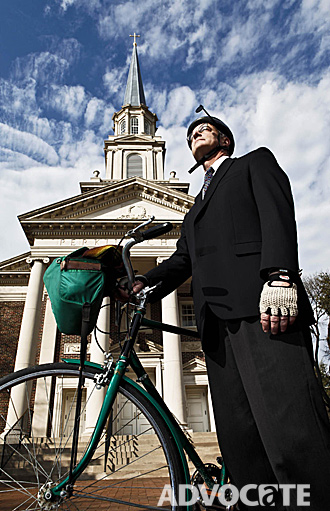
Bill Bryan commutes daily by bike from his home near Flag Pole Hill to his job at Southern Methodist University. Photo by Danny Fulgencio
Don’t let the casual demeanor or his subtle smile fool you, though. He knows what he is up against — honks, close calls, motorists’ angry assertions that bikes don’t belong on roads. A time or two, he has dived into grass out of the way of oblivious and fast-approaching drivers.
Not to mention, as put by one neighbor who believes bikes don’t belong on streets at all, “a cyclist can’t keep up with the flow of cars and one blown tire or pothole could pitch him into traffic and, squish, with no one legally at fault.”
Bryan’s keen awareness that it can be something like a war zone out there has kept him virtually accident free despite many years riding to his job at Southern Methodist University from his home near Flag Pole Hill.
“I go out knowing each day that at least one driver will make a mistake, or take a shot at me,” he says.
The recently approved Dallas Bike Plan aims to not only improve driver and cyclist safety, but also advance public health and fitness and clear up the air. But there’s more to it. The plan also is about changing the neighborhood landscape and bringing us closer together. It’s about creating a culture in which drivers don’t fantasize about running down cyclists (an urge to which many have unabashedly admitted).
The visionaries say a day may come when we can walk outside and see people and faces on two-wheeled rides, rather than just a sea of cars and buildings.
THERE ARE A HANDFUL OF PEOPLE in our neighborhood and city who, like Bryan, get around by bike. But the vast majority drives cars — and some of them have no compassion for cyclists. The editors of Bicycling Magazine, who in 2009 called Dallas the worst city for bicycling, are among the outsiders who consider us a sprawling, car-centric city with enormous arterial roads jammed with impatient, hostile drivers in huge vehicles.
[youtube]http://www.youtube.com/watch?v=XsjMqfmORao&list=UUkop_sok3eslWob18iUPRtg&index=1&feature=plcp[/youtube] VIDEO: Many Dallas cyclists stick to the trail system, which has both advantages and challenges. In this video, Hollywood Heights resident and Pulitzer Prize winning photojournalist David Lesson takes us on a ride through the newest stretch, the Santa Fe Trail, which connects at the southern tip of White Rock Lake.A recent comprehensive study by the Alliance for Biking and Walking ranked Dallas 49 out of 51 major cities for its percentage of residents who cycle to work. We rank 40 out of 51 when it comes to safety for cyclists (based on documented accidents and fatalities). The same study, however, notes that Dallas’ plan to construct more than 1,000 bike lane miles over the next 10 years is among the country’s most ambitious.
ONE SCHOOL OF THOUGHT says bikes don’t belong on the road at all, and that a financially struggling city shouldn’t pay millions — about $16 million for the on-road portion, to be exact — on a bike plan.
“Bike lanes are mostly financed by taxpayer dollars, and our city — hello, we are broke — is in no position to borrow money for bike lanes for the few people who would use them,” says Bill Parker, an Advocate reader.
Another neighbor, Nancy Roberson, thinks that even in a perfect world where everyone follows the rules, bicycles do not belong on the streets.
“For the sake of argument, let’s pretend that everyone — motorists, cyclists — obey the letter of the law and operate defensively and conscientiously. It would never happen, but let’s say anyway, I would still say bikes don’t belong on road. Cyclists need to realize they are the odd man out. And most of them need a large dose of humility and respect for motorized vehicles.”
Some want cyclists on the sidewalk — “If they don’t have a special lane,” says Jerry Keeler, “they need to carefully ride the sidewalk.”

Richard Wharton runs the Cycling Center of Dallas and is a vocal critic of the Bike Plan. Photo by Can Türkyilmaz
But the sidewalk and trails bring a new spectrum of issues — pedestrians, strollers, cracks, curbs and so forth.
Road rage or “bike-lash” directed at cyclists can be vicious and dangerous, too.
“As a paddler who regularly frequents White Rock Lake, I have regular urges to run down both rude, inconsiderate bikers and runners who blatantly disregard the law, common courtesy and their own personal safety. Many almost challenge you to get out of their way,” Mike Stovall says. He is not alone. The spandex and speedy bikes tend to draw the ire of motorists.
Says Bryan, the professor who rides both to work and competitively, he is treated differently depending on how he looks.
“Drivers seem to give you a wider berth when you are riding in a navy blazer, as opposed to a few ounces of spandex.”
But a widespread shift in thinking is occurring, says Park Board member Lee Kleinman, who also served on the Bike Plan Committee. “I think people are frustrated in this urban sprawl that we live in, that you have to get in your car to go to the grocery store. People are starting to look closer in, more local. That’s what enhances the city — closer neighborhoods.”
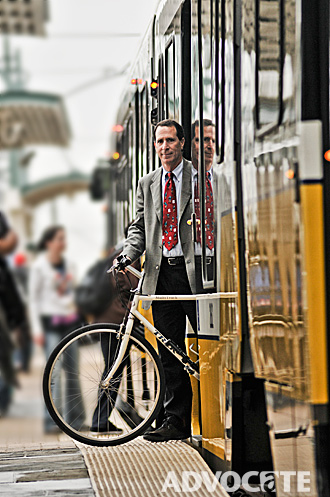
Park Board member Lee Kleinman says the Bike Plan is a necessary expense to increase our neighborhood’s quality of life. Photo by Can Türkyilmaz
Our homes, in large part, have rear-entry garages, Kleinman notes. We often drive down our alley, into our garage and go inside without enjoying any face time with our neighbors. “I think we need to erode that fortress mentality,” Kleinman says. “Bike lanes and bike trails do some of that.”
The overall goal of the Dallas Bikeway System Master Plan, approved by the Dallas City Council last summer, is to create a comprehensive bike system, increase commuter and utilitarian bike trips across the city, raise awareness and education about bicycle safety and eventually create complete streets, which make room for cars, bikes, pedestrians and public transportation. Dallas currently has almost 400 miles of bike routes, mostly in the city’s center, but no bike lanes.
The Dallas Bike plan aims to remedy that. It calls for increasing the number of shared-lane markings, bike lanes and paved shoulders to make the city more bike-able. The city has a good trail system that is improving, and the plan also calls for continuing that work. The impetus for a bike plan is threefold, says the city’s bike coordinator, Max Kalhammer. There’s the environment.
“Part of the reason we got the funding to do the plan update is because North Texas Council of Governments had air quality funds available. Reduced emissions would have a positive impact on the region, not just the city.” Then, there is public health. “Riding a bike to work every day as a transportation choice helps you stay in shape and be healthy and lead a healthy lifestyle, and most people who take active transportation to work are 70 percent less likely to have a heart attack because they’re [exercising] for 40 minutes a day.”
Finally, there’s the ideology shared by Kleinman and others, that a bike plan can shift the landscape, values and culture of our city. “The most important thing about the bike plan is that it represents a moving-forward plan, and choices in the way we live our lives,” Kalhammer says.
| People like Bryan, who has been biking around Dallas for decades, say it contributes immensely to one’s quality of life. Bryan doesn’t commute by bike out of necessity or for environmental reasons but because he really likes it. He talks fondly about his run-ins with nature — “the hawks and butterflies and pigs.”“Cycling around White Rock Lake in the late afternoon leaves you feeling mellow,” he says.
MAKING BICYCLES AN INTEGRAL PART of Dallas’ commuter traffic is doable, many believe, but different cycling proponents have different ideas about how to do it. Bryan believes the bike plan is fabulous, but until it is implemented, he feels confident intermingling with traffic. He always wears a helmet. He understands that, in a fight, a 4,000-pound car beats a two-wheeled piece of aluminum any day. He seeks out the most sparsely populated roads, surfs traffic pulses and even swallows his pride and rides the sidewalk up a short section of Northwest Highway. In Downtown traffic, he rides the bus lane so as not to doubly hold up traffic. He has a handlebar bell, he doesn’t ride in the dark, and he stops at every red light and stop sign. And he is exceedingly courteous. “Sometimes if I see behind me a car has on its turn signal to turn right on a red and I am in front of them, I will hoist my bike up on to the sidewalk and let them turn. You can see them look at you differently when you do something like that.” Bryan uses the trails, though they lack connectivity in some places, and the DART trains to get around. He even hops the TRE to Fort Worth on occasion, where he rides the Trinity Trail and visits the art museum (it’s like a mini European vacation, he says). Mark Manson says that the bike plan, and the consciousness that it raises, will be good for business where he works, at Richardson Bike Mart near the White Rock trail. It will undoubtedly get more people on bikes, he says, and that is good, but he says bike lanes alone aren’t going to keep people safe. First and foremost, he says, cyclists, motorists and pedestrians need to learn the rules of the road. “The fear is that a line painted on the street will provide false security. There also needs to be education and common sense.” Manson, who moved here from New Orleans after hurricane Katrina destroyed his home, says he notices a general trend of Dallas motorists being in a constant hurry. That, and “a cavalier attitude” among some cyclists, contributes to problems on the streets, he says. Woody Smith, the store manager, points out that regulators are making some moves forward in that direction, too. “In 2003 Texas put a law on the books that forces the Department of Public Safety to include bicycle awareness information in the Texas Driver’s Handbook,” Smith says. A simple rule on which most of the cyclists we talked to agree: The trails should be used for leisurely riding and commuting when possible. The roads should be used for training and fast riding. A small group of vehicular cyclists, such as Richard Wharton, reject the whole idea of the bike plan, arguing it sets back the integration efforts of cyclists like him. Laying down a new infrastructure, Wharton says, would basically rewrite the rules of the road that have been established for more than a century — that bicycles are vehicles and should be treated as such via integration, not segregation. “I’m not against the Bike Plan. I’m against the placement of education at the bottom of the list. [Education is] cheap, it’s efficient and it’s quick.” Wharton makes an interesting point. There is something empowering about riding a bike on a busy thoroughfare during rush hour. Pumping along as two-ton vehicles approach from behind, slow down and pass. You own your lane. You are confident, and you understand your rights as a cyclist. Wharton, owner of the Cycling Center of Dallas, demonstrates that bicycles can share the road harmoniously with cars — no bike lanes needed. Thrilling though it may be, most people won’t do it, Kalhammer says. “I just want [the vehicular cyclists] to understand that their way of riding is not for everyone. We’re never going to have a significant number of riders using bikes for work or recreation if we don’t provide these other types of facilities.” |
ROAD RULES• A bicycle is subject to the same traffic laws as cars. • Riding a bike on highways is illegal. • It is legal to ride on sidewalks, except for in Downtown, and cyclists must yield to pedestrians on sidewalks. • A cyclist must touch a foot to the ground at stop signs and can be ticketed for running red lights. • Helmets are required under a Dallas city ordinance. • Cyclists may ride “two abreast,” meaning two side-by-side. • Cyclists may take up as much of a lane as they feel they require. SAFETY• Always use hand signals to communicate with others on the road. • Be careful not to ride too fast in some areas, buy necessary safety accessories such as LED headlights, reflector vests, and even bike bells. You can get them on your local bike shop or online on https://www.myproscooter.com/best-bike-bell/ • When riding in heavy traffic, it usually is safest to ride in the center of the lane so drivers won’t be tempted to pass you within your lane. • When riding at night, consider yourself invisible. Employ a rear light and a strong headlight when it’s dark out. Even with lights, motorists might not see you, so take extra precautions. • When possible, ride in groups. • Never ride against traffic. CYCLIST ETIQUETTE• Always follow the rules of the road. This makes you a good ambassador for cyclists. When motorists see cyclists breaking the rules or behaving dangerously, it makes them angry. • Try not to slow drivers down in situations where it can be avoided, for example: Wave cars through an intersection before you reach it. • When riding on trails, call out to pedestrians to warn them you’re passing. • Don’t race on the trails. Very fast riding is best kept to the streets. MOTORIST ETIQUETTE• Never bully a cyclist. In a fight, a car will win every time. Give cyclists space and be patient when they are ahead of you. • Lay off the cell phone. It is not illegal to text while driving, except in school zones, but it is extremely dangerous. Sources: Dallas city ordinances, cycling advocates |
The guys at the bike store say there is evidence that plans similar to the Dallas Bike Plan work well. “Just look at where it has been introduced in other cities and you will see that it works,” Smith says, adding that — as most seem to agree — “education needs to be a significant component of the overall plan.”
FOR THE TIME BEING, education might be the only affordable solution. With the city facing a sparse bond program in November and a best-case-scenario budget deficit of $50 million, it could be a while before the bike plan is realized.
The city council approved the grandiose plan eight months ago, but the $16 million price tag to be paid out over 10 years, implementing $1.6-$1.8 million worth of on-street bike facilities per year, seemed to catch council members off guard. Though Kalhammer says such costs for striping and signage are pretty typical for any successful on-street bike facilities, “I think much of the council was surprised by that,” says council member Linda Koop, who was an early supporter of updating the bikeway system. She and council member Angela Hunt traveled to Portland about four years ago to study the network. They met with the bike coordinator there to learn strategies they could apply to Dallas.
A Street Services briefing in December revealed that in addition to the initial expense, maintenance would cost up to $3.2 million annually. That raises questions about priorities since the city already struggles to maintain roads, sidewalks and alleys.
One possible solution is to bundle city services to cut costs. When crews re-stripe a road, they add a bike lane while they’re at it.
“We’re still hopeful we’ll get some early wind through the bond program,” Koop says.
Plus, the city’s Sustainable Development and Construction office is seeking grants, including one that would pay for a fundraising position to help raise money in the private sector. Advocacy groups also are trying to raise their own money to help get the plan moving.
“The funding for the infrastructure is the biggest obstacle,” Kalhammer says.
If our city can hurdle the financial obstacles, the Dallas Bike Plan, if implemented correctly, will improve conditions for everyone, Kalhammer says.
“I don’t see it impeding [anyone’s] way of life. It is my hope that once they see how useful riding a bicycle can be, they might even want to try it themselves one day and realize the health benefits of it.”
The city is moving forward with the bike plan, Kalhammer says, and the public will be invited to get involved in the process.
“As we’re implementing the facilities for the different neighborhoods, and we finalize the layouts for each street, we’re probably going to have public meetings to get their input on the amendments.”
Among the first projects will be a connection from the Santa Fe Trail to Downtown and from the White Rock Lake Trail to the Katy Trail.
As for getting people prepared to live in a city built for bicycles, education is indeed vital, Kalhammer says, but the more people we get on bikes, the safer cycling will be.
“We can promote the safe use of the roadways through public address, radio TV billboards, brochures and even safety workshops,” he says.
“But honestly, I think once the momentum of the bicycle culture starts, it’s going to happen organically. Once people start seeing the bike lanes and how they operate, [everyone] will get used to it.”
Park Board member Kleinman agrees that getting more bikes out there, even a few, will spark the culture change that needs to happen before the bike plan can become successful, down the road.
“It does require a cultural change with neighbors and neighborhoods,” he says. “I don’t think we’re ever going to live in this Danish utopia where 40 percent or so of the population goes everyone on their bikes … [however] I don’t think it takes a lot of bikes to make a difference.”
RIDE LIKE THE PROS
Cycling Savvy DFW offers a three-part course at Northway Church, teaching the principles of riding in traffic. It begins with a classroom discussion followed by bicycle training in the parking lot. Finally, cyclists put their skills to the test on a tour of the city. The program started in Orlando, and the curriculum comes from the Florida Bicycle Association. Instructors Richard Wharton, Waco Moore and Eliot Landrum show Dallas students how to cycle safely on any road in Dallas without using sidewalks or hugging the right curb. “You lead the dance,” Wharton says. “A driver is a driver whether it’s on two wheels or four.” The next programs are March 2-3 and April 27-28. The cost is $75. For more information, visit the Dallas section of cyclingsavvy.org.
FREE LESSONS
Richardson Bike Mart offers free bicycling safety workshops. Visit bikemart.com for more information.

